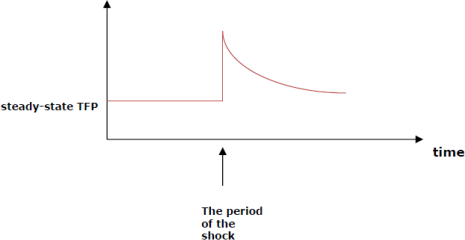ECON8026 Advanced Macroeconomic Analysis Assignment 5 Semester 2, 2022
Hello, dear friend, you can consult us at any time if you have any questions, add WeChat: daixieit
ECON8026 Advanced Macroeconomic Analysis
Assignment 5
Semester 2, 2022
Question 1
Impulse Response Function and Labor Supply: Part 2. Suppose a one-time TFP shock occurs, as shown below.

As we have studied, an increase in TFP leads to an outwards shift in labor demand (recall this from our firm analysis unit), which, as long as the upward-sloping labor supply function does not shift, leads to an increase in the real wage.
Using an infinite-horizon of the combined consumption-savings and consumption-labor framework (which is an extension of the brief two-period framework of Chapter 5), quali- tatively plot an impulse response function for the representative consumer’s optimal labor supply that lines up with the impulse response profile for TFP drawn above. Use the lifetime utility function

in which the utility parameters ψ > 0 (the Greek lower-case letter “psi”) and ν > 0 (the Greek lower-case letter “nu”) are exogenous to the representative consumer.
(You should be able to set up the appropriate budget constraints yourself, although you don’t need to display them if you don’t think you need to.)
Provide brief justification for the impulse response you have sketched.
(HINT: Is this question asking about equilibrium in the labor market or about the aggregate labor supply function?)
Question 2
Preference Shocks, Production Shocks, and General Equilibrium. Suppose that firms and consumers co-exist in the static (one-period) consumption-leisure model. The representative firm uses only labor to produce its output good, which the representative consumer uses for consumption. Suppose the production function is linear in labor, so that output of the firm is given by A . n, where A is a production function shock. Suppose there are no taxes of any kind, and the consumer’s utility function is given by u(Bc, l) (the function u satisfies all the usual properties we assume for utility functions). As usual, B denotes a preference shifter. Finally, the real wage is given by w = A.
a. Briefly explain why the real wage is given by w = A.
For each of the following three questions, clearly sketch your diagrams on ONE SINGLE diagram with consumption on the vertical axis and leisure on the horizontal axis.
b. Suppose currently A = A0 and B = B0 (that is, A0 and B0 are some current values for the production shock and preference shock, respectively). On your diagram, clearly (qualitatively) sketch an indifference map, a budget constraint, and associated optimal choices of consumption and leisure.
c. Suppose a negative technology shock occurs, lowering A from A0 to A1 < A0 . B = B0 still. On your diagram, clearly (qualitatively) sketch an indifference map, a budget constraint, and associated optimal choices of consumption and leisure. Briefly explain any differences between your sketch here and that in part b.
d. Suppose a preference shock occurs, lowering B from B0 to B1 < B0 . The level of productivity is still as in part c (that is, A = A0). On your diagram, clearly (qualitatively) sketch an indifference map, a budget constraint, and associated optimal choices of consump- tion and leisure. Briefly explain any differences between your sketch here and those in part b and part c as well as any key economic interpretation of your result.
2023-02-23